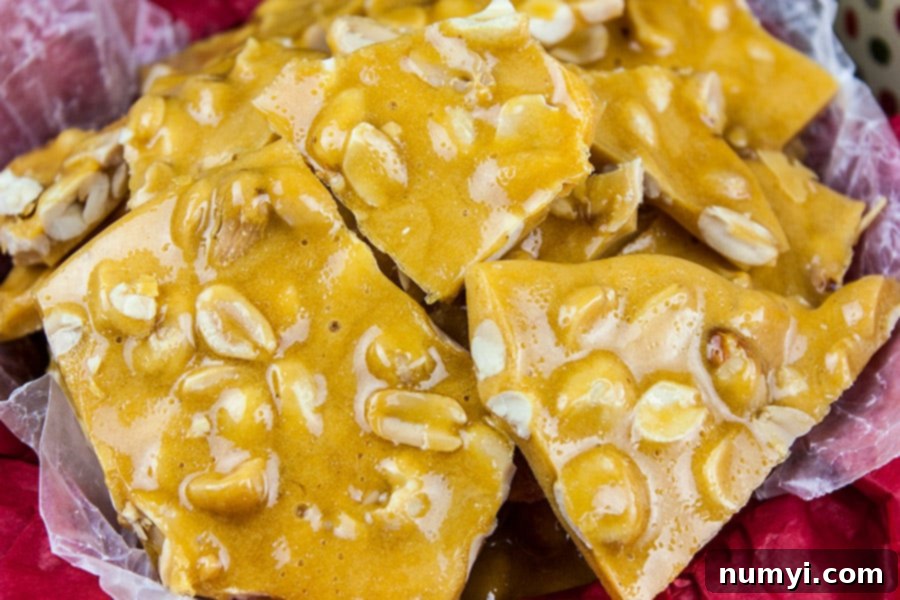Old-Fashioned Peanut Brittle Recipe: The Best Sweet & Salty Homemade Candy
There’s nothing quite like the irresistible crunch and classic flavor of homemade peanut brittle. This isn’t just any peanut brittle recipe; it’s my grandmother’s treasured old-fashioned rendition, perfected over generations. Imagine a delightfully sweet, glassy candy generously studded with roasted, salty peanuts – a combination that’s utterly addictive and guaranteed to bring smiles. This recipe offers a nostalgic taste of tradition, delivering that perfect balance of sweet and savory in every satisfying bite.
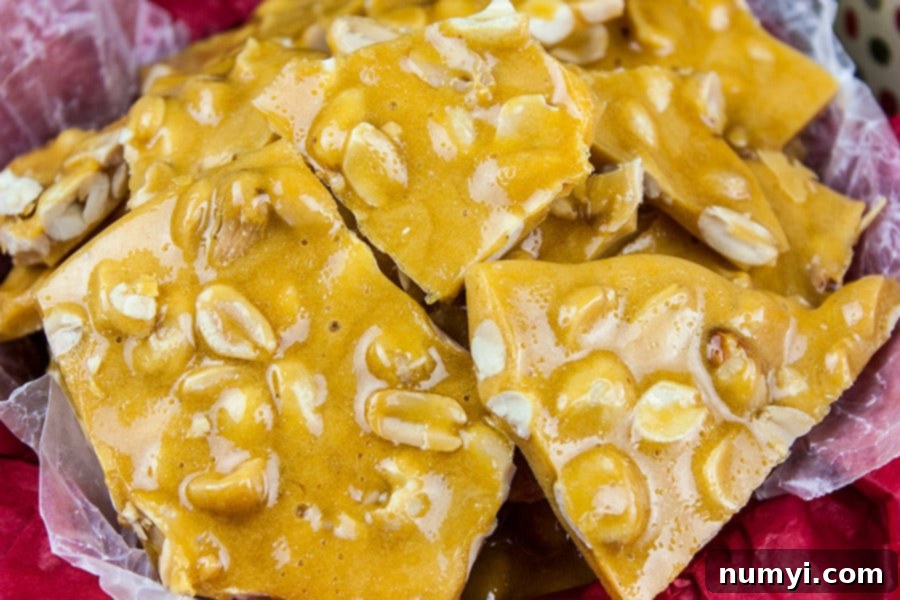
Don’t Sweat The Recipe is supported by its readers. We may earn a commission if you purchase through a link on our site. Learn more.
Why You’ll Adore This Homemade Peanut Brittle
This traditional peanut brittle recipe is a true marvel, and you’ll quickly discover why it’s a family favorite. One of the most surprising aspects is that it achieves a wonderfully rich, buttery-sweet flavor without a single pat of butter in the ingredients list! The magic truly lies in the caramelization process of the sugar and corn syrup.
Forget those bland, often-chewy microwave brittle attempts. This stovetop method ensures a genuinely crispy, melt-in-your-mouth texture that simply can’t be replicated with quicker methods. You’ll achieve a depth of flavor and a satisfying snap that only comes from carefully cooked sugar.
What’s more, this recipe is incredibly quick and straightforward. With just a few simple ingredients, you can whip up a batch of delicious homemade peanut brittle in under 30 minutes of active cooking time! It’s an ideal project for a rainy afternoon or a last-minute gift idea. It shines particularly bright during the festive season, making it perfect for holiday gifting, candy trays, or simply sharing with loved ones.
If you’re fond of crafting delightful homemade treats for friends and family during the holidays, be sure to explore some of our other beloved recipes. You might enjoy our flaky classic shortbread cookies, fun chocolate-covered pretzel rods, rich English toffee recipe, and elegant maple shortbread cookies. Each one is designed to add a special touch to your celebrations!
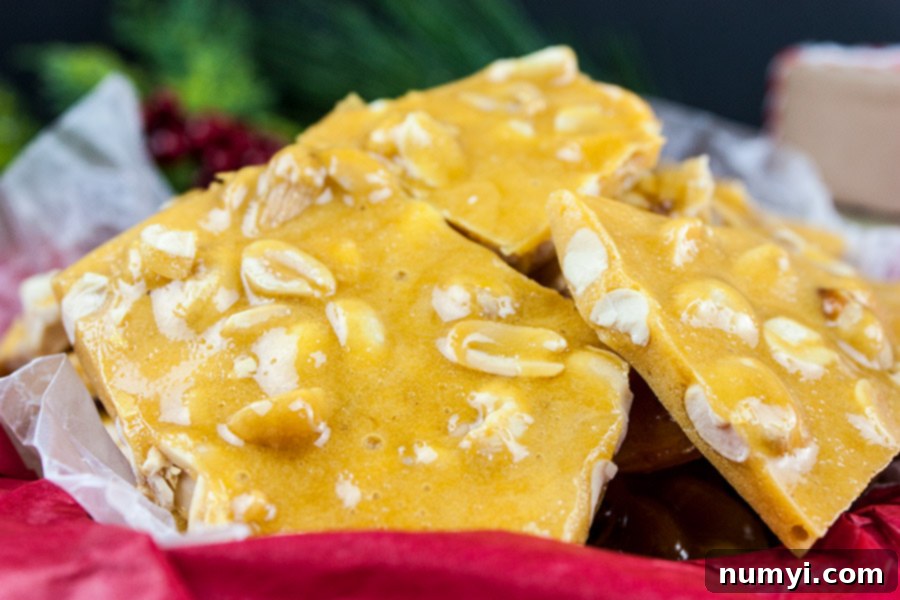
Essential Ingredients for Perfect Brittle
Crafting perfect peanut brittle relies on a few key ingredients, each playing a crucial role in achieving that signature crunchy, sweet, and nutty profile.
- Granulated Sugar and Corn Syrup – These two form the backbone of the candy. While sugar provides the sweetness and the foundation for caramel, corn syrup is the unsung hero. Its primary role is to prevent the sugar from crystallizing, which can result in a grainy, rather than smooth and brittle, texture. It ensures a clear, consistent candy matrix that hardens beautifully. Using corn syrup is vital for achieving the glassy, smooth finish characteristic of classic brittle.
- Baking Soda – This simple pantry staple is what truly transforms hard candy into brittle. When baking soda is added to the hot caramel mixture, it reacts with the acid in the corn syrup (or any other acid present), releasing tiny carbon dioxide gas bubbles. As the candy cools and hardens, these gas pockets become trapped, creating a lighter, more delicate, and porous texture. This is the fundamental difference between brittle and hard, dense toffee – the baking soda introduces that delightful airy crunch.
- Peanuts – The star of the show! We’ll discuss options like raw or roasted later in our tips, but the peanuts provide that wonderful salty contrast and rich nutty flavor that makes peanut brittle so beloved.
- Water and Salt – Water helps dissolve the sugar and corn syrup, allowing them to heat evenly before evaporating. Salt isn’t just for taste; it enhances the nutty flavor of the peanuts and perfectly balances the intense sweetness of the candy.

How to Make Authentic Old-Fashioned Peanut Brittle
Making peanut brittle is a culinary art that requires precision and speed, but it’s surprisingly achievable at home with a bit of focus. Follow these steps carefully for brittle perfection.
1. Prepare Your Workspace
Before you even think about turning on the stove, ensure your cooling surface is completely ready. Line a large, sturdy baking sheet pan with parchment paper. Alternatively, as my grandmother traditionally did, you can generously butter a clean section of your countertop or even directly grease your sheet pan. The key is to have a non-stick surface ready to receive the hot candy immediately.
2. Combine the Base Ingredients
In a large, heavy-bottomed saucepan – a crucial detail to prevent scorching – combine the granulated sugar, corn syrup, water, and salt. Stir these ingredients together until they are well mixed. The heavy bottom of the pan will help distribute heat evenly, which is essential for proper caramelization.
3. Cook to Hard Crack Stage
Place the saucepan over medium-high heat. Bring the mixture to a rolling boil, then continue cooking, stirring constantly. This continuous stirring helps prevent the sugar from burning on the bottom of the pan and encourages even cooking. You’ll need a candy thermometer for accuracy here; cook the mixture until it reaches the ‘hard crack’ stage, specifically between 310ºF and 320ºF. I personally prefer to take mine to 320ºF for a slightly deeper flavor and perfect crispness. This stage is critical for the brittle’s texture.
4. Incorporate Peanuts and Baking Soda
Immediately remove the saucepan from the heat once the correct temperature is reached. Quickly add the peanuts and the baking soda to the hot mixture. Stir vigorously and swiftly to ensure everything is thoroughly combined. The baking soda will react instantly, causing the mixture to bubble and expand – this is exactly what you want for that characteristic brittle texture!
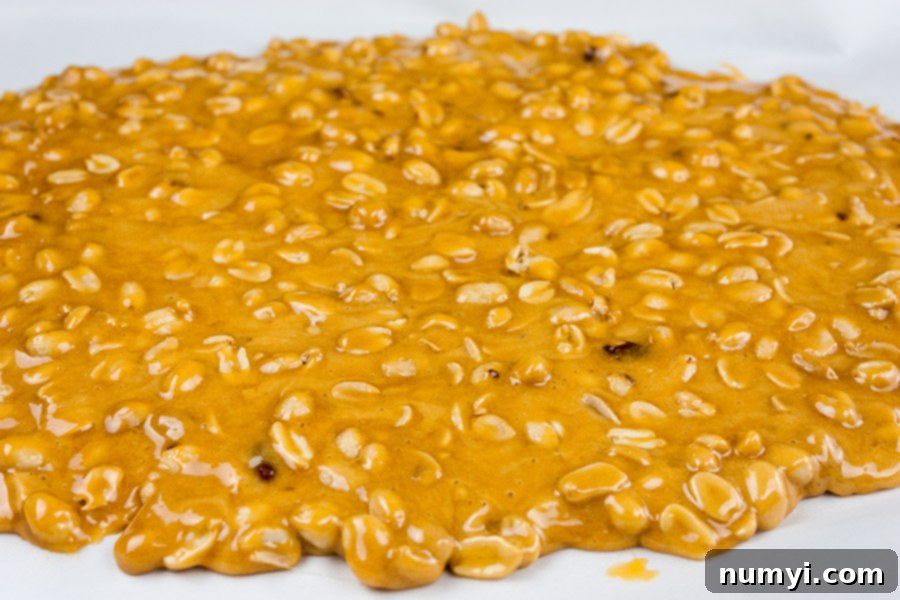
5. Spread and Cool
As soon as the peanuts and baking soda are mixed in, pour the hot candy onto your prepared baking sheet or surface. Work very quickly to spread the peanut brittle to your desired thinness. My grandmother always referred to this step as “stretching” the brittle. The thinner you spread it, the more delicate and crispy each piece will be. Once spread, allow it to cool completely and harden. This can take anywhere from 30 minutes to an hour, depending on your environment.
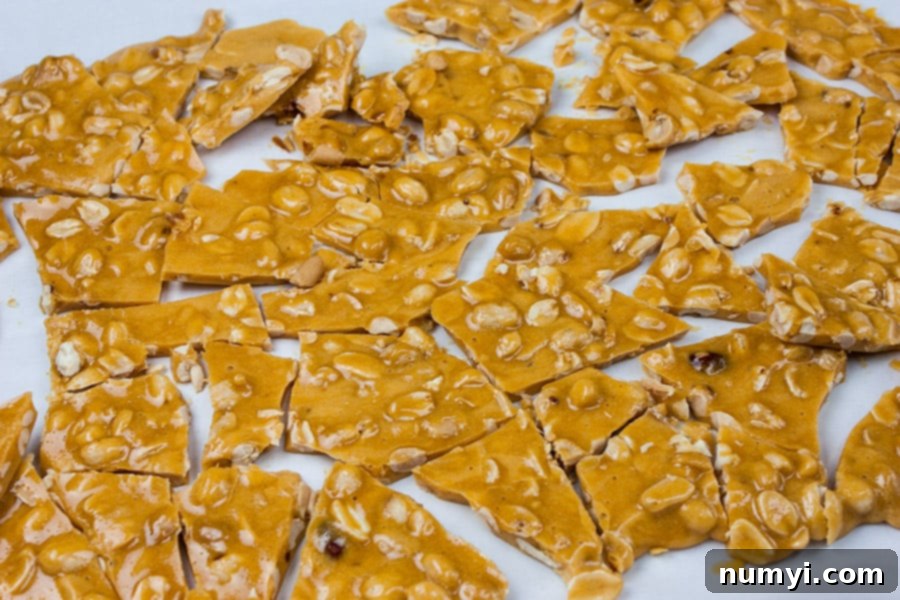
6. Break into Pieces
Once the brittle is entirely cool and hard, it’s time to break it into delicious, irregular pieces. You can use the blunt side of a butter knife to tap and fracture it, or for a more rustic approach, I often use the parchment paper to hold the candy and simply break it with my hands. The satisfying snap as it breaks is part of the fun!
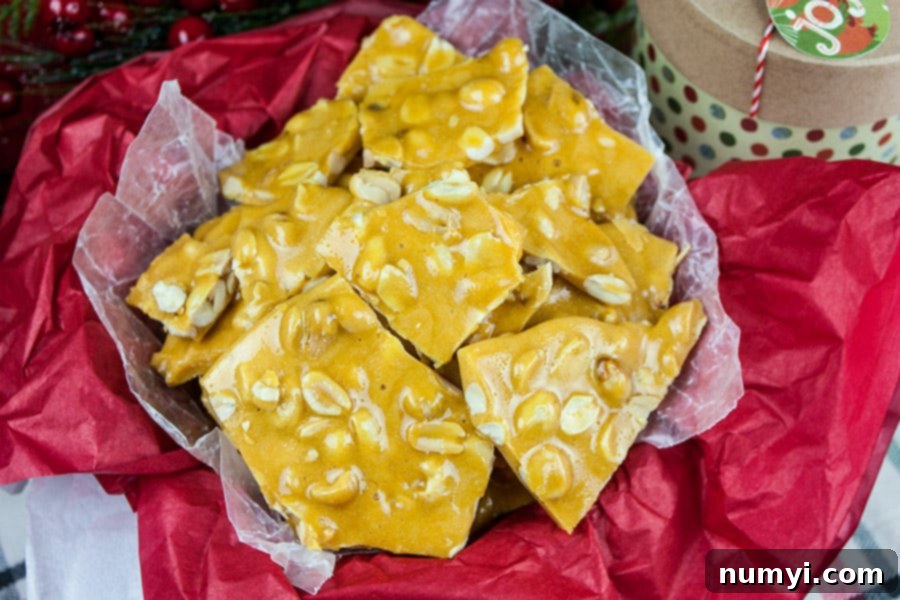
7. Share the Sweetness
This homemade candy makes truly wonderful gifts! Package your beautiful peanut brittle pieces in cute tins or decorative boxes. Homemade treats like this are always cherished during the holidays or for any special occasion.

And remember, before you give it all away, be sure to keep a generous portion for yourself to enjoy! You’ve earned it after crafting such a delightful treat.
Expert Tips for Perfect Peanut Brittle and Creative Variations
Making peanut brittle is an art, and a few insider tips can elevate your homemade candy from good to truly exceptional. Here are some pointers and ways to customize your brittle:
- Peanut Choices: My grandmother traditionally used raw shelled peanuts, stirring them in when the mixture came to a boil, allowing them to roast as the candy cooked. However, I’ve found great success using cocktail peanuts (already roasted and salted) and stirring them in at the very end with the baking soda. This adds an extra layer of saltiness that beautifully cuts through the sweetness and reduces the overall cooking time, as the peanuts are already cooked. Both methods work, so choose what you prefer!
- Nutty Alternatives: Don’t limit yourself to just peanuts! This brittle recipe is highly adaptable. You can easily swap peanuts for other delicious nuts like pecans, pistachios, hazelnuts, or even a mix of your favorites. If using larger nuts, roughly chop them into smaller pieces before adding them to ensure even distribution and easier breaking.
- Safety First: Please remember to be extremely careful when handling the boiling candy mixture. It reaches very high temperatures (over 300°F / 150°C) and can cause serious burns if it splashes onto your skin. Keep children and pets away from the stovetop while cooking.
- Understanding the Hard Crack Stage: The “hard crack” stage is crucial for brittle’s signature texture. This stage typically begins at 300°F (149°C) and goes up to 320°F (160°C). At this temperature, sugar syrup contains almost no water, and when cooled, it will break cleanly and sharply.
- Preparation is Key: This process moves very quickly once the candy reaches temperature. Therefore, it is absolutely essential to prep your baking sheet with parchment paper (or butter your surface) *before* you even start cooking. Have all your ingredients measured and ready to go!
- Invest in a Candy Thermometer: For consistent, perfect results, using a reliable candy thermometer is non-negotiable. It takes the guesswork out of reaching the precise hard crack stage. Ensure your thermometer is calibrated correctly for accuracy.
- The Cold Water Test (No Thermometer?): If you don’t have a candy thermometer, you can try the old-fashioned cold water test. As the candy boils, drop a small amount of the liquid into a glass of very cold water. If it separates into hard, brittle strands that snap easily when bent, it has reached the hard crack stage.
- Humidity Matters: High humidity can affect how brittle hardens and stores. Try to make peanut brittle on a dry day if possible. Humidity can cause the candy to become sticky or chewy.
- Cleaning Up: Don’t try to scrub hardened sugar off your saucepan! Immediately after pouring the brittle, fill the pot with hot water and let it soak. The residual candy will dissolve, making cleanup much easier.
Frequently Asked Questions About Peanut Brittle
Yes, we strongly recommend using corn syrup for this easy peanut brittle. Corn syrup is a type of inverted sugar that helps prevent the granulated sugar from crystallizing during the cooking process. Without it, your brittle is much more likely to turn out grainy or sugary, rather than smooth and glass-like. Other liquid sugars like honey, agave, or molasses contain impurities and different sugar profiles that can burn at the high temperatures required for brittle, leading to an unpleasant bitter taste.
If your peanut brittle is too hard, it usually means it was slightly overcooked, going beyond the ideal hard crack stage. If it’s too chewy or sticky, it’s likely due to too much moisture remaining in the candy, meaning it was undercooked. Ensure you cook the mixture until all the water has evaporated and it consistently reaches 320°F (160°C) on a candy thermometer to achieve the perfect crisp texture.
The most reliable way to know when your brittle is done is by using a candy thermometer. Cook the mixture until it consistently reads 320°F (160°C). This temperature signifies that the sugar has reached the “hard crack” stage, where it will harden into a crisp, non-sticky candy. If you don’t have a thermometer, refer to the “cold water test” described in our tips section.
Moisture is the ultimate enemy of crisp peanut brittle! To maintain its crunchy texture, store it in an airtight container or bag. You can layer pieces with parchment or wax paper to prevent them from sticking together. Keep the container at room temperature in a cool, dry place. Stored properly, your homemade peanut brittle will stay fresh and delicious for up to 2 weeks.
Yes, peanut brittle freezes remarkably well! Once the brittle has cooled completely and been broken into pieces, place them in a single layer in a freezer-safe airtight container or heavy-duty freezer bag. You can layer with parchment paper if needed. Freeze for up to 2 months. Thaw at room temperature before serving. Be aware that repeated freezing and thawing can sometimes affect the texture.
Explore More Delicious Sweet Treats
If you loved making this classic peanut brittle, you’ll surely enjoy these other delightful recipes perfect for any occasion, especially during the festive season. They are all great for sharing or simply indulging your sweet tooth!
Old Fashioned Chocolate Peanut Butter Balls Recipe
Chocolate Orange Fudge
Butter Pecan Fudge
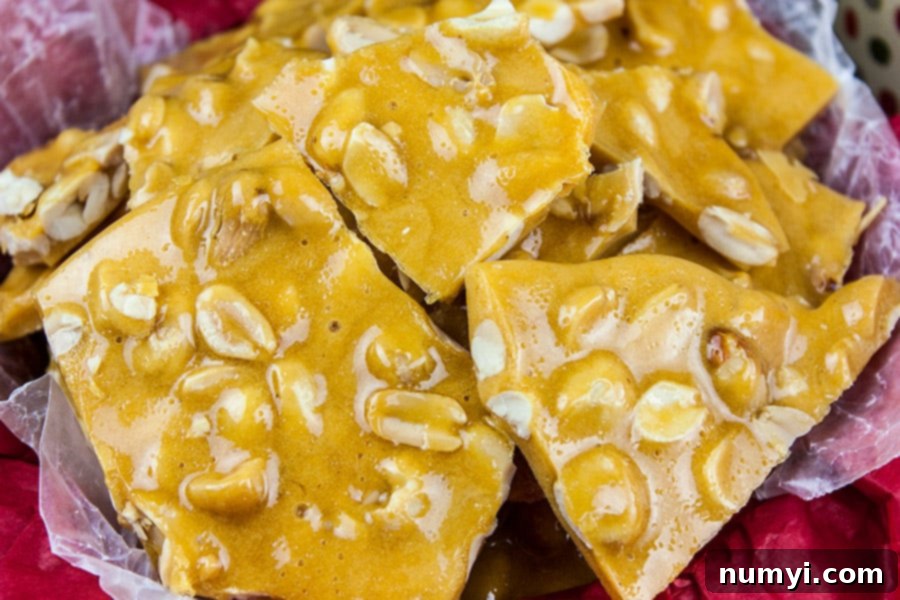
Old Fashioned Peanut Brittle Recipe
Print
Pin
Rate
Ingredients
- 2 cups peanuts* (raw or cocktail)
- 2 cups granulated sugar
- 3/4 cup light corn syrup
- 1/4 cup water
- 1/4 teaspoon salt
- 1/2 teaspoon baking soda
Instructions
-
Line a large baking sheet pan with parchment paper or generously butter your countertop. Have this ready before you start cooking.
-
In a large, heavy-bottomed saucepan, combine the granulated sugar, water, corn syrup, and salt. Stir gently to mix.2 cups granulated sugar, 3/4 cup light corn syrup, 1/4 cup water, 1/4 teaspoon salt
-
Bring the mixture to a boil over medium-high heat. Continue cooking, stirring constantly, until a candy thermometer registers between 310ºF and 320ºF (the hard crack stage). (For best results, I aim for 320ºF.)
-
Immediately remove the saucepan from the heat. Quickly stir in the peanuts and baking soda until well combined. The mixture will bubble and expand.2 cups peanuts*, 1/2 teaspoon baking soda
-
Pour the hot peanut brittle onto the prepared parchment paper (or buttered surface) and quickly spread it to your desired thinness using a buttered spoon or spatula. Work swiftly as it cools fast!
-
Allow the brittle to cool completely and harden at room temperature. Once firm, break it into irregular pieces.
Notes
No Thermometer? Try the Cold Water Test: If you don’t have a candy thermometer, you can try the cold water test. Drop a tiny amount of the boiling candy liquid into a glass of very cold water. It should immediately separate into hard, brittle strands that snap easily. This indicates it has reached the hard crack stage.
Storing Your Brittle: Moisture is the enemy of peanut brittle. Store cooled, broken pieces in an airtight container or bag, layered with parchment or wax paper to prevent sticking. Keep it at room temperature for up to 2 weeks for optimal crispness.
Freezing for Longer Storage: To freeze, ensure the peanut brittle is completely cool. Break it into pieces, then place them in a single layer in a freezer-safe container or bag. You can add parchment between layers. It can be frozen for up to 2 months. Thaw at room temperature before enjoying.
